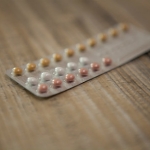About 3-5% of women of reproductive age suffer from premenstrual dysphoric disorder (PMDD), where they experience depressive symptoms, anxiety or irritability during the last one to two weeks (the premenstrual phase) of their menstrual cycle. In addition, many women who suffer from depression, including those who have been effectively treated with an antidepressant, report worsening of their depressive symptoms during the premenstrual phase of the menstrual cycle. Although this may be a consequence of sensitivity to fluctuating hormone levels, little is known about the efficacy of hormonal interventions, including oral contraceptives (OCPs), in the treatment of premenstrual worsening of depressive symptoms.
At the 2005 annual meeting of the American Psychiatric Association in Atlanta, Georgia, Dr. Hadine Joffe from the Center for Women’s Mental Health presented preliminary data assessing the efficacy of the OCP Yasmin for the treatment of premenstrual worsening of depression. These women were 18-45 years of age and had regular menstrual cycles. All of the women had a depressive disorder (major or minor depression or dysthymia) and had been doing well on an antidepressant for at least 2 months except for premenstrually, when their depression symptoms would re-emerge. During the first month of the study, all participants completed a tracking month to prospectively determine that depressive symptoms were present only during the premenstrual phase (Montgomery-Åsberg Depression Rating Scale [MADRS] > 14) and increased in severity during the premenstrual phase (Daily Record of Severity of Problems Scale [DRSP] increase by > 50% over follicular phase ratings). Subjects with significant mood symptoms during the follicular phase of the cycle (MADRS > 10) were excluded.
Women with premenstrual worsening of depression were randomized to augmentation of their antidepressant (mostly serotonin-based) with Yasmin. Yasmin is an OCP that is a combination of ethinyl estradiol and a unique progesterone, drospirenone. All participants took Yasmin for 2 months. Yasmin was selected because other studies have found that it improves selected PMS symptoms (Freeman EW, 2002).
With 35 participants enrolled, an interim analysis revealed that 89% of the subjects screened had prospectively confirmed premenstrual worsening of depression. For the first 17 subjects who had completed the study at the time of the presentation, premenstrual DRSP scores for all subjects together were reduced from median 54.4 to 35.3 after 2 months of OCP therapy (p=0.005), while DRSP scores during the follicular phase remained low and were not affected by OCP treatment. Premenstrual MADRS scores were similarly reduced (p=0.008) while follicular phase MADRS scores remained stable and low. Only 2 of 25 (8%) of women who started OCP treatment were unable to tolerate it because their depression got worse on the OCP.
This interim analysis indicated that 2 months of Yasmin treatment improved premenstrual mood symptoms in women whose depression was otherwise well treated with an antidepressant. In addition, almost all women who report premenstrual worsening of depression were confirmed to have premenstrual breakthrough of depressive symptoms when prospectively assessed. Although this study is preliminary, it is the first to demonstrate that adding oral contraceptives to an antidepressant may be useful for women with depressive disorders who experience premenstrual worsening of their mood despite effective antidepressant treatment throughout the rest of their menstrual cycle. Further analysis of the data will determine whether continued use of estradiol during the placebo week may provide additional benefit.
Ruta Nonacs, MD, PhD
Hadine Joffe, MD, MSc
These data were presented as a poster at the 2005 Annual Meeting of the American Psychiatric Association. Click here to see the Poster presented by Dr. Hadine Joffe.
*This post was originally published as an article from our Summer 2005 newsletter.








Leave A Comment